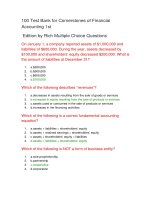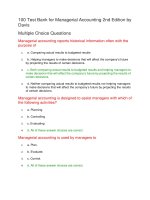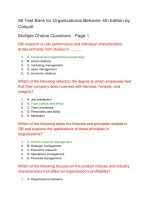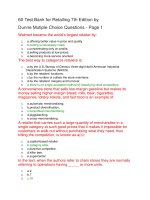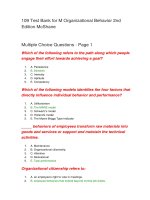130 test bank organizational behavior 7th edition by mcshane đề thi trắc nghiệm
Bạn đang xem bản rút gọn của tài liệu. Xem và tải ngay bản đầy đủ của tài liệu tại đây (175.29 KB, 33 trang )
Test Bank Organizational Behavior 7th Edition by McShane
68 Test Bank True – False Questions
9 Test Free Text Questions
53 Test Bank Multiple Choice Questions
In the field of organizational behavior, organizations are described as:
1.
A. entities which are considered a legal grouping of people and systems.
2.
B. groups of people who work independently to achieve a collective goal.
3.
C. social entities with a publicly stated set of formal goals.
4.
D. groups of people with independent profit-centered motives and objectives.
5.
E. groups of people who work interdependently towards some purpose.
The perspective that effective organizations incorporate several
workplace practices that leverage the potential of human capital is called
the _____ perspective.
1.
A. HPWP
2.
B. learning
3.
C. human capital
4.
D. intellectual capital
5.
E. open-systems
Which discipline has provided organizational behavior with much of its
theoretical foundation for team dynamics, organizational power, and
organizational socialization?
1.
A. Sociology
2.
B. Psychology
3.
C. Economics
4.
D. Industrial engineering
5.
E. Political science
Deep-level diversity includes:
1.
A. physiological differences.
2.
B. attitudes.
3.
C. ethnicity.
4.
D. gender.
5.
E. All of these.
According to the multiple levels of analysis anchor:
1.
A. organizational behavior is mainly the study of how all levels of the
organizational hierarchy interact with the external environment.
2.
B. OB topics typically relate to the individual, team and organizational levels of
analysis.
3.
C. there are eight levels of analysis that scholars should recognize when
conducting OB research.
4.
D. organizational events can be studied from only one level of analysis.
5.
E. corporate executives need to understand business ethics from various levels
and perspectives.
Which organizational behavior perspective discusses inputs, outputs, and
feedback?
1.
A. Organizational learning
2.
B. Open systems
3.
C. Multidisciplinary
4.
D. Systematic research
5.
E. Intellectual capital
Which of the following perspectives of organizational effectiveness
argues that companies take their sustenance from the environment and, in
turn, affect that environment through their outputs?
1.
A. Stakeholder
2.
B. Systematic research
3.
C. High-performance work practice
4.
D. Organizational learning
5.
E. Open systems
The triple bottom line philosophy says that:
1.
A. companies should pay three times as much attention to profits as they do to
employee wellbeing.
2.
B. the main goal of all companies is to satisfy the needs of three groups:
employees, shareholders, and suppliers.
3.
C. business success increases by having three times more contingent workers
than permanent employees.
4.
D. companies should treat their local, national, and global customers fairly.
5.
E. companies should try to support the economic, social, and environmental
spheres of sustainability.
Organizational behavior knowledge:
1.
A. originates mainly from models developed in chemistry and other natural
sciences.
2.
B. accurately predicts how anyone will behave in any situation.
3.
C. is more appropriate for people who work in computer science than in marketing.
4.
5.
D. helps us to understand, predict, and influence the behaviors of others in
organizational settings.
E. is important only for the managers of an organization.
The topic of ethics is most closely associated with the _____ perspective.
1.
A. stakeholder
2.
B. systems
3.
C. high-performance work practices
4.
D. open systems anchor
5.
E. contingency
Your roommate, Allison Albright, is a non-business major. When she
discovered that you are taking a course in Organizational Behavior, she
was thoroughly confused as to why one would need to study OB and what
it entails. Based on what you have studied, can you help Allison obtain
knowledge of organizational behavior? Allison thinks that organization is
the same as an organism. However, in the field of organizational behavior,
organizations are best described as:
1.
A. legal entities that must abide by government regulations and pay taxes.
2.
B. physical structures with observable capital equipment.
3.
C. social entities with a publicly stated set of formal goals.
4.
D. groups of people who work interdependently towards some purpose.
5.
E. any social entity with profit-centered motives and objectives.
Which of the following is most closely associated with corporate social
responsibility?
1.
A. Knowledge management
2.
B. Triple bottom line
3.
C. Absorptive capacity
4.
D. Adaptive ability
5.
E. Knowledge acquisition
Eastern University performs a daily computer search through newspaper
articles to identify any articles about the university or its faculty members.
University administrators use this information to receive feedback about
how the public reacts to university activities. In knowledge management,
searching for newspaper articles and other external writing about the
organization is mainly a form of:
1.
A. knowledge acquisition.
2.
B. grafting.
3.
C. organizational unlearning.
4.
D. knowledge sharing.
5.
E. documentation.
_____ diversity includes differences in the psychological characteristics
of employees, including personalities, beliefs, values, and attitudes.
1.
A. Reflective
2.
B. Deep-level
3.
C. Organizational
4.
D. Surface-level
5.
E. External.
ACME Software Inc. has developed a training program to make employees
more aware of how their job performance affects customers and other
employees within the organization and to inform them of the changing
market conditions. This training program relates most closely with which
of the following concepts?
1.
A. Contingency anchor
2.
B. Grounded theory
3.
C. Open systems
4.
D. Virtual teams
5.
E. Telecommuting
As part of the knowledge management process, experimentation is
conducive to:
1.
A. measuring intellectual capital.
2.
B. knowledge acquisition.
3.
C. increasing organizational memory.
4.
D. knowledge sharing.
5.
E. unlearning.
Which of the following statements is true about globalization and
organizational behavior?
1.
2.
3.
A. Globalization has little or no effect on organizational behavior.
B. Globalization has forced organizational behavior researchers to study only large
multinational businesses.
C. Globalization offers numerous benefits to organizations.
4.
D. Globalization has forced organizational behavior textbooks to discuss only
companies with headquarters in North America.
5.
E. Globalization does not have a significant impact on today's organizations.
Which of the following is an example of globalization?
1.
A. A footwear firm based in San Diego opens a new branch in Los Angeles.
2.
B. A car company based in Pittsburgh manufactures its cars in Philadelphia.
3.
C. Rewind, a German music band which plays traditional German folk music
performs in Berlin.
4.
D. Rowan, a French citizen, publishes a novel within France.
5.
E. An American-based burger joint opens a new outlet in China.
A firm has good associations with its customers, suppliers, and others
who provide added mutual value for the firm. Name the form of intellectual
capital that is possessed by the firm due to its good associations.
1.
A. Structural capital
2.
B. Intellectual capital
3.
C. Human capital
4.
D. Knowledge capital
5.
E. Relationship capital
As an owner and manager of Tricky Toys, Bob Baldwin has been
fascinated by all the changes occurring and transforming the workplace.
Bob is concerned about the important OB trends that he can understand
and take advantage of in developing and positioning his company in the
marketplace. If Bob wants to study deep-level diversity in his organization,
he would:
1.
2.
A. review the demographic characteristics of his workforce.
B. consider the likelihood of long-term employment with the organization for each
of his employees.
3.
C. observe the differences in the people who represent his workforce.
4.
D. look at different attitudes and expectations of his employees.
5.
E. research the cultural and racial background of the workforce in the industry.
As an owner and manager of Tricky Toys, Bob Baldwin has been
fascinated by all the changes occurring and transforming the workplace.
Bob is concerned about the important OB trends that he can understand
and take advantage of in developing and positioning his company in the
marketplace. Bob has been interested in this trend of globalization. He
should know that globalization occurs when an organization:
1.
A. increases its connectivity with people and organizations in other parts of the
world.
2.
B. serves diverse customers within the firm's home country.
3.
C. has a diverse workforce within the firm's home country.
4.
D. has a substantially strong domestic market.
5.
E. operates in a country with strict foreign trade policies.
Employees, suppliers, and governments:
1.
A. are organizational stakeholders.
2.
B. are rarely considered in organizational behavior theories.
3.
C. represent the three levels of analysis in organizational behavior.
4.
D. are excluded from the open systems anchor.
5.
E. are independent units in an organizational set up.
_____ refers to the study of moral principles or values that determine
whether actions are right or wrong and outcomes are good or bad.
1.
A. Performance orientation
2.
B. Ethics
3.
C. Multicultural teams
4.
D. Legal obligations
5.
E. Organizational behavior
_____ refers to an organization's moral obligation toward all of its
stakeholders.
1.
A. Values
2.
B. Legal obligation
3.
C. Multicultural teams
4.
D. Corporate social responsibility
5.
E. Organizational behavior
Your roommate, Allison Albright, is a non-business major. When she
discovered that you are taking a course in Organizational Behavior, she
was thoroughly confused as to why one would need to study OB and what
it entails. Based on what you have studied, can you help Allison obtain
knowledge of organizational behavior? To help Allison understand some
preliminary information about OB, which of these statements about the
field is true?
1.
A. Organizational behavior scholars give more importance to individual
characteristics than structural characteristics.
2.
B. The field of organizational behavior is independent of the concepts and theories
from other fields of inquiry.
3.
C. Organizational behavior emerged as a distinct field late in the 1990s.
4.
D. Given the specific utility of the field, OB is useful for the managers in the
organizations but not for the employees.
5.
E. Organizational behavior scholars study what people think, feel, and do in and
around organizations.
Twice every year, a major car parts manufacturer brings together the
production and engineering specialists from its eight divisions to discuss
ideas, solutions, and concerns. This helps to minimize the 'silos of
knowledge' problem that exists in many organizations. This practice is
primarily an example of:
1.
A. grafting.
2.
B. experimentation.
3.
C. knowledge sharing.
4.
D. documentation.
5.
E. organizational unlearning.
Stable, long-lasting beliefs about what is important in a variety of
situations are:
1.
A. called intellectual capital.
2.
B. the foundations of the open systems anchor.
3.
C. the main reason why virtual teams fail.
4.
D. rarely studied in the field of organizational behavior.
5.
E. called the values of the organization.
The observable demographic or physiological differences in people, such
as their race, ethnicity, gender, age, and physical disabilities constitute
_____ diversity.
1.
A. deep-level
2.
B. internal
3.
C. surface-level
4.
D. organizational
5.
E. reflective
Which of the following is true according to the systematic research
anchor?
1.
A. OB topics typically relate to the individual, team and organizational levels of
analysis.
2.
B. OB should import knowledge from other disciplines, not just create its own
knowledge.
3.
C. OB theory should recognize that the effects of actions often vary with the
situation.
4.
5.
D. A particular action may have different consequences in different situations.
E. OB should study organizations by forming questions, collecting data, and
testing hypotheses against those data.
Your roommate, Allison Albright, is a non-business major. When she
discovered that you are taking a course in Organizational Behavior, she
was thoroughly confused as to why one would need to study OB and what
it entails. Based on what you have studied, can you help Allison obtain
knowledge of organizational behavior? Allison should understand that
organizational behavior knowledge:
1.
A. should never be used to influence the behavior of other people.
2.
B. should be used only by managers and senior executives.
3.
C. should never replace common-sense knowledge about how organizations work.
4.
D. is relevant to everyone who works in organizations.
5.
E. is an independent science that has evolved independently.
Out of the generational groups discussed in the textbook, which group
has the highest preference for leisure and the lowest value of social
interaction?
1.
A. Gen-Xers
2.
B. Gen-Yers
3.
C. Baby Boomers
4.
D. Millennials
5.
E. Silent Generation
The ability to recognize the value of new information, assimilate it, and
use it for value-added activities is known as _____.
1.
A. perception ability
2.
B. realization capacity
3.
C. observation skill
4.
D. absorptive capacity
5.
E. adaptive capacity
As an owner and manager of Tricky Toys, Bob Baldwin has been
fascinated by all the changes occurring and transforming the workplace.
Bob is concerned about the important OB trends that he can understand
and take advantage of in developing and positioning his company in the
marketplace. Bob is considering the idea of implementing telecommuting
in Tricky Toys. Which of the following is an advantage of telecommuting?
1.
A. Reduced employee stress
2.
B. Larger markets
3.
C. Greater demand for firm's products
4.
D. Enhanced employee recognition
5.
E. Ability to recognize the value of new information
According to the open systems view of organizations, _____ is (are) an
input for organizations.
1.
A. incentive plans
2.
B. products
3.
C. financial resources
4.
D. employee motivation
5.
E. employee behavior
Intellectual capital refers to the:
1.
A. total spending on training and development of employees.
2.
B. total number of employees in the organization.
3.
C. total cost of computers and other 'intelligent' machines in the organization.
4.
D. stock of knowledge that resides in an organization.
5.
E. cost of hiring a typical employee.
Which of the following is a conceptual anchor in organizational behavior?
1.
A. Contingency anchor
2.
B. Economic anchor
3.
C. Social anchor
4.
D. Single level anchor
5.
E. Scientific anchor
Which of the following is a form of knowledge acquisition?
1.
A. Observation
2.
B. Experimentation
3.
C. Documentation
4.
D. Internal communication
5.
E. Group discussion
Which of these organizational behavior trends is corporate social
responsibility most closely related to?
1.
A. Workforce diversity
2.
B. Employment relationships
3.
C. Information technology
4.
D. Globalization
5.
E. Workplace values and ethics
At Clickz, an American photography magazine firm, more than half of the
senior management positions are held by women. African Americans
represent 40 percent of the company's workforce. The description of
Clickz's diversity refers to:
1.
A. deep-level diversity.
2.
B. psychological diversity.
3.
C. personality diversity.
4.
D. surface-level diversity.
5.
E. attitude diversity.
A computer maintenance company wants to 'capture' the knowledge that
employees carry around in their heads by creating a database where
employees document their solutions to unusual maintenance problems.
This practice tries to:
1.
A. transform intellectual capital into knowledge management.
2.
B. transfer human capital into structural capital.
3.
C. prevent relationship capital from interfering with human capital.
4.
D. reduce the amount of human capital.
5.
E. transfer structural capital into relationship capital.
Organizations retain intellectual capital by:
1.
A. transferring employee capital into structural capital.
2.
B. encouraging employees to take early retirement.
3.
C. discouraging employees from communicating with each other.
4.
D. reducing the level of documentation in organizations.
5.
E. building strong human capital.
_____ refers to economic, social, and cultural connectivity with people in
other parts of the world.
1.
A. OB
2.
B. Globalization
3.
C. Work/Life balance
4.
D. Knowledge management
5.
E. Corporate social responsibility
Which of the following typically results in a loss of intellectual capital?
1.
A. The employees help the organization discover opportunities.
2.
B. The employees protect the firm from threats in the external environment.
3.
C. The company sells one of its divisions and its employees now work for the
other organization.
4.
D. The workers help in documentation of work procedures.
5.
E. The company has a good physical layout of the production line.
Which of these statements is consistent with the five anchors of
organizational behavior?
1.
A. Organizational behavior theories must apply universally to every situation.
2.
B. Organizations are like machines that operate independently of their external
environment.
3.
C. Each OB topic relates to only one level of analysis.
4.
D. The field of organizational behavior should rely on other disciplines for some of
its theory development.
5.
E. Organizational behavioral decision making does not require evidence from
research.
Organizational behavior views organizations as:
1.
A. non-systems.
2.
B. a single unitary subsystem.
3.
C. open systems.
4.
D. closed systems.
5.
E. a system without interactions with the external environment.
Mick works for a company as a financial analyst from home using
information technology. He does not work in a traditional physical
workplace. This trend is known as:
1.
A. deep-level diversity.
2.
B. work-life balance.
3.
C. virtual work.
4.
D. surface-level diversity.
5.
E. frictional unemployment.
Which of the following statements is consistent with the concept of
contingency anchor?
1.
A. To obtain the best results, actions should be taken without considering their
consequences.
2.
B. A particular action may have different consequences in different situations.
3.
4.
5.
C. OB theories are based on simple, common-sense ideas about what managers
should do.
D. OB theories point out the one best way to resolve organizational problems.
E. Organizations should never be viewed as systems that process inputs to
provide outputs.
Which of the following statements is true about human capital in an
organization?
1.
A. Human capital helps the organization use opportunities more than realizing
them.
2.
B. Existence of human capital increases the threats in the external environment.
3.
C. Human capital is non-substitutable though it is abundant.
4.
D. Human capital is independent of the challenges of the external environment.
5.
E. It is a key variable in the HPWP model of organizational effectiveness.
Which of the following statements is true about organizational behavior?
1.
A. OB researchers systematically study various topics at a single level rather than
at multiple levels.
2.
B. It is concerned with the study of people who work independently.
3.
C. It does not include the study of collective entities.
4.
D. It is less effective in studying people who interact in highly organized fashion.
5.
E. It includes team, individual, and organizational level analyses.
The open systems anchor of organizational behavior states that:
1.
2.
A. organizations affect and are affected by their external environments.
B. organizations can operate efficiently by ignoring changes in the external
environment.
3.
C. people are the most important organizational input needed for effectiveness.
4.
D. organizations should avoid internal conflicts to achieve efficiency.
5.
E. organizations should be open to internal competition to be able to obtain a
sustainable competitive advantage.
Which of the following statements is true of organizational behavior
knowledge?
1.
A. It is relevant to everyone who works in organizations.
2.
B. It should never be used to influence the behavior of other people.
3.
C. It should be used by managers and senior executives alone.
4.
D. It should not be used by subordinates to influence the behavior of their
managers.
5.
E. It is less significant when the level of interpersonal interaction is high.
Which of these statements is true about the field of organizational
behavior?
1.
A. It examines how individuals and teams in organizations relate to one another
and to their counterparts in other organizations.
2.
B. OB researchers systematically study various topics at a common level rather
than at multiple levels.
3.
C. Information technology has almost no effect on organizational behavior.
4.
D. The field of organizational behavior relies exclusively on ideas generated within
the field by organizational behavior scholars.
5.
E. The origins of organizational behavior are traced mainly to the field of
economics.
The _____ perspective, also called knowledge management, views
knowledge as the main driver of competitive advantage.
1.
A. open systems
2.
B. organizational learning
3.
C. stakeholder
4.
D. systematic research
5.
E. shared values
68 Free Test Bank for Organizational Behavior 7th
Edition by McShane True - False Questions - Page 1
Organizations that have high employee turnover will be better able to
retain intellectual capital within the organization.
1.
True
2.
False
OB knowledge is beneficial not only to an individual, but also to an
organization's financial health.
1.
True
2.
False
Organizational behavior emerged as a distinct field around the 1940s.
Before that, organizations had not been studied at all.
1.
True
2.
False
The perspective that effective organizations incorporate several
workplace practices that leverage the potential of human capital is called
high-performance work practices.
1.
True
2.
False
Organizational behavior encompasses the study of how organizations
interact with their external environments.
1.
True
2.
False
Three challenges organizations are facing include globalization,
increasing workforce diversity, and emerging employment relationships.
1.
True
2.
False
The knowledge, skills, and abilities of employees are examples of
structural capital.
1.
True
2.
False
In order for something to be called an organization, it must have certain
assets such as buildings and equipment.
1.
True
2.
False
Studying OB does not make a difference in one's career success.
1.
True
2.
False
German sociologist Max Weber wrote about rational organizations and
systematic ways to organize work processes and motivate employees
through goal setting and rewards.
1.
True
2.
False
Studying OB at multiple levels is not recommended as it could lead to
perceptual errors.
1.
True
2.
False
Open systems cannot exist without dependence on an external
environment, whereas closed systems can exist without dependence on
an external environment.
1.
True
2.
False
High performance work practices build human capital, which improves
performance as employees develop skills and knowledge to perform the
work.
1.
True
2.
False
The open systems perspective emphasizes that organizations survive by
adapting to changes in the external environment.
1.
True
2.
False
According to the organizational learning perspective, an effective
organization not only learns but also unlearns certain routines and
patterns of behavior.
1.
True
2.
False
According to the open systems perspective, most organizations have one
working part rather than many sub-components.
1.
True
2.
False
All organizations have a collective sense of purpose, whether it's
producing oil or creating the fastest Internet search engine.
1.
True
2.
False
Intellectual capital includes, among other things, the knowledge captured
in an organization's systems and structures.
1.
True
2.
False
The best organizational practices are those built on the notion that
organizations are closed systems.
1.
True
2.
False
The best indicator of a company's effectiveness is how well it achieves its
stated objectives.
1.
True
2.
False
The organizational learning perspective is focused on physical resources
that enter and are processed in the organization.
1.
True
2.
False
Investment portfolio studies suggest that specific OB characteristics are
important "positive screens" for selecting companies with the best longterm share appreciation.
1.
True
2.
False
Working in a self-directed team reduces employee motivation because
employees in such a team will support individualistic behaviors rather
than team behaviors.
1.
True
2.
False
Organizational behavior knowledge is strictly for managers, not for
working level employees.
1.
True
2.
False
Employee involvement is a widely recognized high-performance work
practice.
1.
True
2.
False
The "human relations" school of management emphasized the study of
employee attitudes and informal group dynamics in the workplace.
1.
True
2.
False
Organizational effectiveness is considered the "ultimate dependent
variable" in organizational behavior.
1.
True
2.
False
A company's success is only mildly influenced by the quality of its CEO.
1.
True
2.
False
The best yardstick of organizational effectiveness is a composite of four
perspectives: open systems, organizational learning, high-performance
work practices, and stakeholders.
1.
True
2.
False
One of the fastest ways to acquire knowledge is to hire individuals or
purchase entire companies that have valued knowledge.
1.
True
2.
False
Intellectual capital represents the stock of knowledge held by an
organization.
1.
True
2.
False
Until the 1930s, most organizational research and practice tried to
improve work efficiency by changing working conditions and job duties.
Employee thoughts and feelings were ignored and usually considered
irrelevant.
1.
True
2.
False
The greatest value of OB knowledge is that it helps us to get things done
in the workplace.
1.
True
2.
False
68 Free Test Bank for Organizational Behavior 7th
Edition by McShane True - False Questions - Page 2
Telework is better suited to those who are seeking sufficient fulfilment of
social needs elsewhere in their life.
1.
True
2.
False
All popular management concepts rely on hard evidence that proves they
are valid.
1.
True
2.
False
Globalization offers numerous benefits to organizations in terms of larger
markets, lower costs, and greater access to knowledge and innovation.
1.
True
2.
False
Values are relatively stable, evaluative beliefs that guide our preferences
for outcomes or courses of action in a variety of situations.
1.
True
2.
False
The evidence-based management approach embraces scientific methods
because they produce more valid theories to guide management
decisions.
1.
True
2.
False
Everyone agrees that organizations need to cater to a wide variety of
stakeholders.
1.
True
2.
False
The systematic research anchor relies mainly on qualitative data and
subjective procedures to test hypotheses.
1.
True
2.
False
Stakeholders of an organization are shareholders, customers, suppliers,
governments and any other groups with a vested interest in the
organization.
1.
True
2.
False
Globalization refers to economic, social, and cultural connectivity with
people in other parts of the world.
1.
True
2.
False
Surface-level diversity is evident in a person's decisions, statements, and
actions.
1.
True
2.
False
An organization's employees use information technology to perform their
jobs away from the traditional physical workplace. This is an example of
virtual work.
1.
True
2.
False
Deep-level diversity refers to the observable demographics such as age,
gender and race.
1.
True
2.
False


